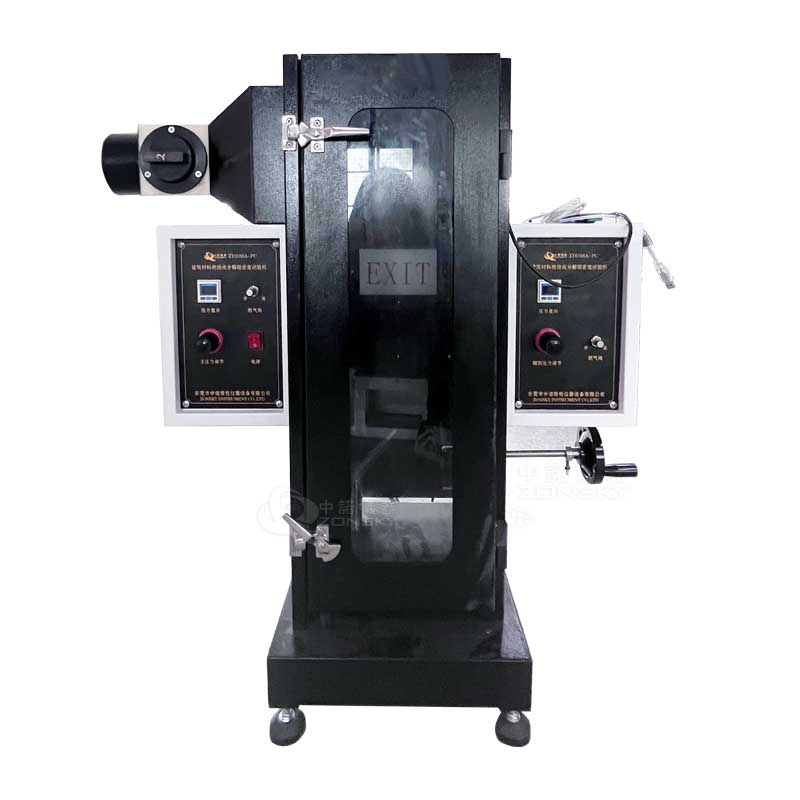
ISO 19700 Smoke density testers are used to determine the fire resistance and smoke-generating characteristics of materials such as plastics, rubber, textiles, and other materials.
Smoke Density Tester,in accordance with ASTM D2843, is an experimental device used to evaluate the density of smoke produced by materials under fire conditions.
smoke density tester usually consists of the following parts:
1.Combustion Chamber: An enclosed space that holds the material to be tested and simulates fire conditions.
2.Smoke Collector:Used to collect smoke from the combustion process and introduce it into the measurement system.
3.Optical Measurement System: Used to measure the optical density of the smoke, usually using a photodiode or photoelectric sensor to detect the intensity of light passing through the smoke.
1.Sample Preparation:The material to be tested is placed in the test combustion chamber and prepared according to the requirements in the ASTM D2843 standard.
2.Ignition Test:Under conditions that meet the standard, the material to be tested is ignited and the smoke produced during the combustion process is observed and recorded.
3.Smoke Density Measurement: The density of the smoke is measured using an optical measuring system, and the optical density values of the smoke at different points in time are recorded.

Parameters typically considered for smoke density testers include:
1.Smoke Density: The concentration of particulate matter in smoke, usually expressed as optical density.
2.Smoke Generation Rate : the amount of smoke produced per unit of time, reflecting the rate at which the combustion of the material produces smoke.
Smoke density testers are commonly used in various fields such as construction, aerospace, and electronics to evaluate the amount of smoke produced and the degree of material diffusion during fire-related situations. This information is used to develop effective fire safety designs and protective measures..
The smoke density tester has the following advantages:
Accuracy: the use of optical measurement system, can accurately measure the optical density of smoke, providing reliable test data.
Repeatability:The test process is standardised to provide repeatable test results, which facilitates comparison of the smoke generation properties of different materials.
It is suitable for the determination of static smoke production when building materials and their products are burned, and can also be used for the determination of static smoke production when other solid materials are burned.
Comply with ASTM D2843 standard requirement.
1. Gas source: 95% propane gas, or coal gas of equivalent purity (prepared by the customer);
2. Burning lamp: Bunsen burner, length 260mm, nozzle diameter 0.13mm, 45° angle with the smoke box;
3. Photoelectric system: The light source is a light bulb, with a power of 15W and a working voltage of 6V;
4. Exhaust system: This machine is equipped with a powerful exhaust fan, which can discharge the exhaust gas outside after the test;
5. Smoke density measurement range: 0~100%;
6. Smoke density measurement accuracy: ±3%;
7. Receiver: It is a silicon photovoltaic cell. A transmittance of 0% means no light passes through; a transmittance of 100% means that light passes completely without obstruction;
8. Focal length after processing: 60~65mm;
9. Main burner working pressure: 276KPa (adjustable);
10. Auxiliary burner pressure: 138KPa (adjustable);
11. Automatic timing, manual ignition (with manual igniter), automatic smoke exhaust; luminous flux can be automatically corrected;
12. Computer control, including a set of transmittance measurement software, which can output curve reports, automatically save data and can be printed.
1. This machine consists of two parts: a combustion box and a computer control system;
2. Combustion box size: L300*W300*H790 (mm);
3. The combustion box is made of high-quality baking paint and processed by CNC machine tools, with a beautiful and large arc shape;
4. Internal parts are made of high-quality stainless steel with excellent anti-rust performance;
1. The ground should be flat, well ventilated, and free of flammable, explosive, corrosive gases and dust.
2. There are no strong electromagnetic radiation sources nearby.
3. Leave appropriate maintenance space around the equipment.
4. Test conditions: (23±2)℃, humidity (50±5)% (the purchaser must prepare its own qualified laboratory)
5. Power supply: AC220V/50HZ.
6. Allowable voltage fluctuation range: 220V±10%.
7. Allowable frequency fluctuation range: 50Hz±1%.
8. The user is required to configure an air or power switch of corresponding capacity for the equipment at the installation site, and this switch must be independent and dedicated to the use of this equipment.
9. This test machine is jointly developed by our ZONSKY and the "Science and Technology Department of Sichuan Fire Research Institute of the Ministry of Public Security", and has unique global leading technology.
 WhatsApp:
WhatsApp: Mobile Phone:
Mobile Phone: Contact Now
Contact Now